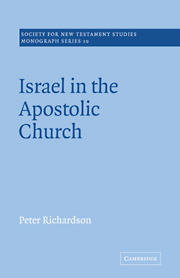I - THE CHURCH AND ISRAEL
Published online by Cambridge University Press: 05 March 2010
Summary
THE HISTORICAL PROBLEM
The word ‘Israel’ is applied to the Christian Church for the first time by Justin Martyr c. A.D. 160. It is a symptom of the developing take-over by Christians of the prerogatives and privileges of Jews. Initially there is hesitancy about this transposition : but a growing recognition of the necessity to appropriate titles and attributes ensures a complete transfer. The date A.D* 160 corresponds roughly with the beginning of a new attitude to Judaism. Prior to this time there is a measure of continuity between the Church and Israel: they are able to talk together, in some places to worship together, to expect and receive converts from one to the other; but after the mid-second century these possibilities seem to disappear and discontinuity becomes more radical.
The break did not happen suddenly. It is clear that the appropriation of ‘Israel’ as a designation for the Church is not itself the motivation for a change in attitude, but is the sign of something far more profound. Justin's Dialogue with Trypho, in which this transposition is effected at last, is not itself the great divide. In the creative step in which the equation is made explicit—‘Church’ = ‘true Israel’—Justin gives accurate expression to a long-standing tendency to increase the degree to which Christianity views itself as the heir of all which Israel once possessed. Justin also witnesses to the fact that in A.D. 160 there is still a sensitivity to the close relationship which obtains between Christianity and Judaism: Justin and Trypho can talk reasonably, without malice, and to a large extent from common ground.
- Type
- Chapter
- Information
- Israel in the Apostolic Church , pp. 1 - 8Publisher: Cambridge University PressPrint publication year: 1969

